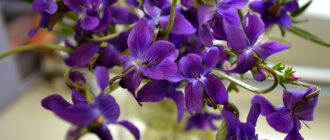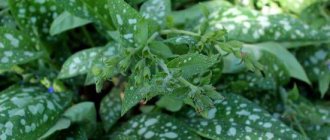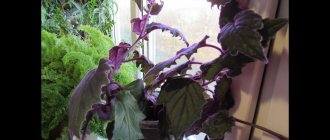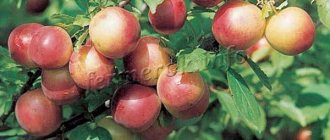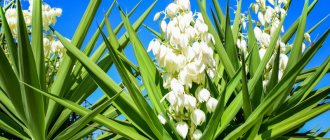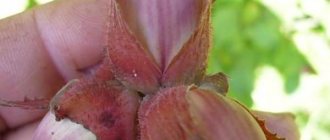Yucca description
The most beautiful plant, Yucca, is shaped like a palm tree, which is why it is confused with these representatives. In fact, it is not related to the palm plant family.
Yucca occurs as a shrub or large tree. In our latitudes, it is represented as a large shrub. The leaves are dense and hard, green in color. Sometimes there are varieties where the foliage is covered with yellow and white veins, shaped like a long and thin sword, and the edges are razor-sharp. The leaves may stick out in different directions or, on the contrary, be drooping.
In nature, the foliage of yucca reaches up to a meter in length. But at home, they grow up to 60 cm. When yucca blooms, it becomes even more beautiful. Once a year, large buds appear on the plant, blooming in the form of bells. Flowers are found white, yellowish or pinkish. In rare cases, specimens are found with a sky blue color. They are collected in a large panicle, strewn with hundreds of buds stretching upward. And they originate in the middle of the leaf rosette.
Important. Yucca has fruits in the form of berries or small capsules with seeds. But, unfortunately, the beauty blooms only in its natural environment. Because to pollinate a bush, you need a special butterfly that lives only in the tropics or subtropics.
Description
There are more than 20 species of this plant. Another name for it is false palm. It was nicknamed that way because of its appearance; indeed, the resemblance to a palm tree is very strong. And the Indians called it the “Tree of Life.”
This tree-like perennial plant can winter well in the open air of the Caucasus, Crimea, Ukraine and all southern regions. In the northern regions it is grown as an indoor potted plant.
Garden yucca has taken root well in gardens in the southern regions of the country. She feels comfortable in gardens and parks. It grows slowly. It begins to bloom at the age of three years.
An evergreen perennial, it can be a tree or shrub, depending on the species. The trunk is of various sizes, can be several centimeters high, or can grow several meters.
The tree trunk grows straight or has several branches, the maximum height is up to 12 m. The leaves are arranged in a rosette pattern; they are elongated along their entire length and often have thorns. The leaves are dense, hard, located on a shortened stem.
The color of the leaves is dark green with a bluish tint.
It blooms in the summer and is an unusually beautiful sight. Flowering lasts for 3 weeks. During flowering, the false palm tree transforms and becomes even more attractive and exotic.
The flower is a huge candle assembled from many flowers that look like a bell. It has a pleasant aroma, similar to the smell of expensive soap.
The flowers themselves are edible and have a pleasant taste, similar to green beans or artichokes. They are often added to salads or omelettes.
There are bred frost-resistant varieties of false palm. Yucca frost-resistant is a perennial plant that can winter outdoors for several years in cold climates. But, unfortunately, after several years of growing it in a garden or park, the trunk begins to become overgrown with bark, which is vulnerable to cold weather factors.
Frost-resistant species include: gray and filamentous false palm. These species can feel great in frosts down to -18-20 degrees below zero.
Origin
An evergreen beauty, native to North America, and to be precise, from its southern regions. These areas have an arid climate. But to say that yucca does not require watering at all would not be correct. This plant can often be seen on the islands of the Caribbean Sea, where there is high humidity. What yucca does not tolerate is cold winter. And so that it does not die in our latitudes, during the cold season, it is carefully covered and prepared for wintering.
Important. In its homeland, yucca is used not only for decoration, but also as an industrial shrub. The leaves are used to create fiber for clothing. This thread is strong and quite often serves as the basis for jeans. In addition, sugar and dye are obtained from yucca.
Preparing for transplant
Preparations for replanting a palm tree begin a week before the procedure, at which time the soil in which it will develop during the next growing season is pre-prepared.
A special substrate is suitable for growing this species; it is often prepared with one’s own hands from a mixture of turf, leaf soil, river sand and humus (2:2:2:2:1). Sand can be replaced with perlite or vermiculite, which are just as good at giving the substrate the desired lightness and looseness.
Before planting, the soil must be sterilized. This event is carried out in several ways:
- wetting with a 1% solution of potassium permanganate;
- roasting in the oven for 20–25 minutes at a temperature of +125 °C;
- heating in the microwave for 5–10 minutes (at maximum power);
- freezing in the freezer at -20. -25 °C for 2–3 days.
Sterilized soil is placed in a separate container and kept at room temperature for 7 days. This is necessary for the soil to restore its consistency, as well as its microflora.
Palm trees are planted in deep garden containers; containers made of ceramics or clay are best suited for these purposes. They are able to absorb moisture, which will protect the yucca from waterlogging. Plastic containers are also suitable for planting, but in this case you need to be more careful about the watering regime.
The bottom of the pot must contain a drainage hole; stagnation of moisture is detrimental to the plant, which is fraught with putrefactive lesions of the roots. A successful pot must be 2–3 cm in diameter larger than the volume of the rhizome. These indicators are approached strictly, since a large or excessively small container will lead to oppression of the palm tree.
Immediately before planting, sterilize the pot and drainage layer (small pebbles, gravel or expanded clay). This is a mandatory measure; after replacing the pot, the yucca exhibits growth inhibition; sterilization helps protect it from infectious agents, to which it is especially susceptible during this period.
Disinfection is carried out in two ways:
- heating in the oven (at +125 °C, about 25 minutes);
- treatment with 1% solution of potassium permanganate, 70% alcohol solution.
Yucca indoor propagation
Why is Yucca propagated? Once a person acquires this amazing plant, he will want to get even more copies of the beauty for his home or to give it as a gift. And the green corner created with the help of yucca will not leave a single person indifferent. This plant can be called a diamond in home decor. Yucca is propagated in several ways, namely:
- tops;
- cuttings;
- offspring;
- seeds;
- trunk;
- shoots;
- kids.
Each method of reproduction is simple and does not require much effort and time. And thanks to home breeding, the gardener receives additional plants for his green collection.
Tops
If the gardener plans to create several fan-shaped tops on the yucca trunk. Then you need to wait until the plant grows to 35 cm in height. Then, use a knife to cut off the top of the yucca so that a couple of leaves remain on the main plant. The cut is sprinkled with charcoal, crushed to a powdery state. Young shoots will soon appear in the place where the cut was made.
At the same time, the cut off tops are used to produce a new plant. They are dried in an air bath for a couple of hours, then immersed in wet sand or water. If the option with water is chosen, before use, it is subject to heat treatment and cooled to room temperature.
You need to keep an eye on the bottom leaves of the cut tops that are in water or sand. If they begin to rot, it is recommended to remove all damaged elements and replace the water with fresh water. When the first roots appear, the yucca is planted in a separate pot.
Cuttings
On the trunk of the yucca, there are dormant buds that can produce new shoots. All the beneficial substances that the plant receives from the soil are sent to the development of the crown, and while it is on the trunk, the buds will not wake up and will not produce new shoots. Several new shoots are obtained by cutting the trunk into pieces, 20 cm each.
The finished pieces are immersed in a moist substrate with the addition of sand, with the buds inward, to form roots. And cover the container with a glass jar. The mini greenhouse is placed in a secluded corner, where the temperature is maintained at +20ºС, spraying the substrate daily. After two weeks, roots will appear, each cutting is planted in an individual pot.
To obtain new shoots using the cutting method, it is better to use the period from February to April.
Offspring
Throughout the warm season, yucca is covered with root shoots. They get rid of them so that the plant grows better. Do not rush to throw away the extra roots; using them, you will get new yucca bushes.
In autumn, the sprouts are carefully cut from the parent plant and planted in damp sand. After planting, water generously and cover with a glass jar on top.
It takes about two months for a new sprout to form, so throughout the entire process, the jar is regularly opened and ventilated. This procedure must be performed a couple of times a week. Be sure to ensure that the room temperature where the containers with the offspring are located is at least +20ºС.
When new roots appear on the roots, they are planted in an individual pot. There is no rush to replant, giving time for strong rooting. After the first roots appear, at least 2 weeks must pass before planting in a permanent place.
This method is the only one that involves growing yucca in the fall.
Seeds
Yucca produces a large number of seeds in its homeland. In our latitudes, it practically does not bloom. But if its seeds appear for sale in a flower shop, you can try to get shoots this way. The main condition is that the seed must be fresh. In other words, no older than one year.
To obtain sprouts using seeds, make containers in the form of a greenhouse. The turf soil is mixed with sand in a 1:1 ratio and thoroughly moistened. The seed material is laid out on the surface of the mixture without pressing it. Cover the top with glass or film to create a greenhouse. Remove the glass or film every day for ventilation and moisten the soil a couple of times a week. Due to this procedure, the first shoots appear after four weeks.
Trunk
Yucca flower is propagated by stem sections throughout the summer. This is one of the easiest breeding methods. The trunk is cut into pieces 15 cm wide. Then all the cut pieces are placed in moist soil with the buds facing the ground and pressed. In just a couple of weeks, the first shoots will appear. They are carefully separated and planted in separate pots. And the place of the cut on the plant is covered with garden varnish.
This is a simple method that does not require painstaking care. In a short period of time, new shoots are obtained.
By shoots
Propagation by stem shoots is carried out in early spring. Strong shoots are cut from the trunk of an adult bush. Pay close attention to the cuts on the parent plant; you cannot make them deep, as this will damage the trunk and lead to death. The cut itself is covered. Garden pitch or activated carbon, crushed to a powder, will be effective.
The shoot is placed in sandy soil, previously well moistened. If you follow all the recommendations correctly, the sprout will become stronger within a month.
Children
With proper care of yucca, babies can appear in the first year of its life. And separating root or stem shoots is beneficial for the parent plant. It is necessary to ensure that there are no more than six children on the trunk, for normal growth and development of the main bush; extra children are harmful.
The shoots are carefully cut off from the parent tree with a knife. The depth of the cut is controlled; it is not advisable to make it deep so as not to harm the main trunk. When the babies are separated, they are planted in a container with wet sand. Water generously and cover with a glass jar.
Containers with babies are placed on the sunny side and kept at room temperature +20ºС. Water the shoots every week and monitor the moisture content of the sand.
The roots of a young yucca will appear within two months. After this period, the plant is transplanted into a pot for further growth. But the substrate is first prepared and fertilized. Soil intended for cacti or palm plants is also ideal for yucca. It is purchased in specialized stores.
Propagation by stem cuttings
Yucca can be propagated by cuttings , which are taken from part of the trunk cut from a healthy plant with a bare stem. Next you need to perform the following manipulations:
A piece of yucca trunk must be placed horizontally on the surface of wet sand or loose soil in a pot. The cuttings do not need to be sprinkled with soil; you just need to press them lightly into the ground.
After some time, the dormant buds of the trunk will become active and release new shoots, growing roots along the way.
Next, you need to remove from the sand, divide it with a sharp and clean knife into parts according to the number of shoots, and sprinkle the sections with crushed charcoal. You need to leave the shoots in the air for a while to dry them a little.
Then each shoot must be planted in a separate container with soil.
You can also purchase a piece of yucca stem from a flower shop. To determine the top and bottom, as a rule, the top of the cutting is filled with wax, which must be removed after planting. Such cuttings root very easily and quickly as follows:
- to begin with, a piece of stem should be placed with the lower end in a solution of a growth stimulator for two or three days; “Heteroauxin” is perfect for this;
- Next, you need to plant the cutting with its lower end in the ground, lowering it to a depth of 3 to 5 cm;
- the soil in a pot with rooting yucca should always be moist, but not wet;
- after the first leaves appear, watering should be reduced;
- Then the yucca should be watered as the earthen clod dries out.
If the cutting purchased at a flower shop is not marked with wax, it must be rooted according to the scheme described above, placing it horizontally on the ground, and then separating the resulting shoots.
How to propagate yucca if there are aerial roots
This method of propagation is used when the roots of an adult plant rot. If there are healthy areas on the yucca trunk, new roots are obtained from them.
Select a place on the trunk, 15 cm above the root system and 50 cm below the top, remove the bark around the trunk 5 mm wide. The cut site itself is covered with damp moss and wrapped with polyethylene on top. Moss is regularly moistened. See the photo below for step-by-step instructions on how to perform this manipulation.
After a couple of weeks, new roots will grow where the bark was cut. They wait the next week to strengthen the young root system, constantly moisturizing it. Then the top of the yucca is cut off along with the roots and transplanted into a new pot. And the cut on the old trunk is sprinkled with crushed activated carbon or covered with garden pitch.
Next, the remaining cutting, where the root system is partially damaged, is transplanted into a new pot with fresh substrate mixed with sand. Before planting, the cuttings are removed from rotten roots, carefully removing them with a knife so as not to accidentally damage healthy ones.
Important. For any chosen reproduction option. The optimal temperature for the growth of new shoots should be within the range from +20°C to +25°C. All small sprouts are placed on the sunny side and maintain the moisture of the substrate.
How to propagate and root yucca?
Young offspring are most often obtained from an adult healthy plant. Already in the first years of cultivation, with proper care, a false palm tree can produce several shoots. Cuttings are rooted in water or wet sand. You can use expanded clay or specially formulated soil.
Components for soil mixture:
- washed sand - 1 part;
- humus (preferably leafy) - 0.5 parts;
- turf soil - 1 part.
Ready-made soil for rooting cuttings can be purchased at the store.
A plant planted in the ground forms its first roots within two months.
Experts recommend propagating indoor palm trees using one of the following methods:
- trunk parts;
- air layering;
- cut off top;
- offspring;
- seeds.
Vegetative propagation begins in April-May. This is a period of active growth for yucca, so rooting goes especially well. Separation of offspring is also best done in spring and summer or during transplantation of an adult bush.
Necessary conditions for the propagation of yucca
To obtain new specimens of yucca, certain rules are followed. When propagating, yucca shoots love warm places with high humidity.
The ideal place would be a greenhouse. If it is not possible to grow shoots in special greenhouses, such conditions are created independently. A room is selected where the shoots will grow, with the condition that the room temperature will be at least +20°C, above +25°C; it is undesirable to exceed the temperature, otherwise the intense heat will dry out all the moisture.
Each sprout is planted in a separate container; a regular kitchen vessel will do. The main thing is to cover the container with glass or polyethylene to create increased humidity inside. Such conditions will help to grow small sprouts into a beautiful yucca plant.
Propagation by seeds
In indoor conditions, yucca, as a rule, does not bloom . To form flower buds, the plant needs a long, cold winter outside.
However, if the gardener is lucky enough to receive seeds from a flowering plant or purchase them at a flower shop, you can grow yucca from them according to the following scheme.
It is very important to ensure the freshness of the seeds. You need to soak them in warm water for a day. Next, you need to prepare the substrate from the following components:
- 1 part leaf soil;
- 1 part of turf land;
- 1 part coarse sand.
The container with seedlings must be covered with glass or a plastic bag to create optimal conditions for germination - humidity and heat.
Every day you need to ventilate the seedlings and wipe the glass with a dry cloth. A month after sowing, you can wait for the first shoots to appear.
Reproduction in open ground
There are over fifty varieties of yucca. In addition to indoor plants, there are also garden plants that grow well in open ground. And in order to plant a garden beauty, certain conditions are created, namely:
- the plant is planted in a sunny place protected from strong winds;
- mid-spring is the ideal time for planting.
The soil should be nutritious; the ideal option would be to prepare it yourself and replace garden soil.
As for the landing time, the best time of year is spring. When night frosts are over and the temperature does not drop below +7 C. It is not recommended to plant immediately. It is necessary to give the sprouts time to adapt to outdoor conditions. To do this, the yucca is taken outside for several hours every day. Gradually increasing the time intervals. The plant gets used to the weather conditions and after a week, it is ready for planting.
How to plant yucca correctly
Experienced gardeners recommend planting a false palm tree after gradually hardening it off.
To do this, the newly acquired seedling needs to be exposed to the sun gradually. In the first 3-4 days, she should be in the fresh air for about 1-2 hours. In the next 3-4 days, it can be left outside for 3-4 hours. Then for another 5-6 days you can leave it for up to 6 hours.
After such hardening, we can plant our palm tree in the prepared soil.
Planted in spring or summer, depending on climatic conditions. During planting, the daytime temperature should be at least 20-22 degrees Celsius. Only under such planting conditions will the root system prepare for the winter period.
The soil must be well drained. The soil acidity level is approximately pH 7.5. Choose an open, well-lit area for planting. Yucca is a southern plant, but the abundance of sunlight does not have a favorable effect on the color of the foliage, so the area should be sunny, but during the daytime sun it is desirable to have partial shade.
To plant a false palm tree, you should prepare the soil in advance. The area for planting should be mulched generously with sawdust or hay, so that moisture does not evaporate from this area for as long as possible.
To plant, you need to dig a deep hole. The size of the hole must exceed the size of the root system.
Some plants that cannot tolerate cold are moved indoors for the winter. It is for such plants that you should dig a larger hole and plant the yucca along with the pot.
In this way, it grows outside in the summer, like a garden tree, and in the winter, the pot along with the plant is simply dug up. This is very convenient; there is no need to disturb the roots again.
Yucca transplant
Replanting a houseplant is done once every two years. When a plant has more than one trunk, it needs to be replanted. And this manipulation is performed in this way:
- The trunk is divided into several parts along with the root.
- All cut areas are sprinkled with crushed activated carbon or covered with garden pitch.
- Each sprout resulting from division is planted in a separate pot.
You can replant indoor yucca at any time of the year. But the most optimal time will be spring. The plant needs to be prepared for transplantation. To begin, cut off a third of the foliage and immerse the root in warm water for a couple of hours.
It is imperative to ensure that the root system is not damaged during replanting. Yucca loves vitamin supplements; they are applied directly to the new soil.
Important. If you follow all the rules of care and planting, a luxurious beauty will grow from a small yucca, which will become the most beautiful decoration of your home.
After the purchase
When purchasing a plant, it is replanted within two days. A new pot for yucca is chosen a few centimeters larger than the old one.
The best pots for the plant are considered to be clay or ceramic pots, due to their natural origin and drainage hole of a suitable size. Although containers made of plastic are also successfully used, after making an additional hole in them to drain excess water. This type of container is more affordable, and is no worse in use than clay ones.
When the pot is chosen, planting begins. Drainage is poured into the bottom of the container, in the form of fine gravel or red brick broken into pieces. Then the prepared soil is poured over the drainage. It can be purchased at a specialty store or prepared with your own hands. The main thing is that there is sand.
Carefully remove the yucca from the old pot. The earthen lump present on the root cannot be removed. The plant is placed in a new pot and covered with substrate on the sides, compacting it with a spatula. The planted plant is watered abundantly.
Next, the pot with yucca is transferred to a dark place. And maintain a temperature regime of +25°C. For a week, the yucca is sprayed three times a day with water. After a week of adaptation, the flower is chosen to have a sunny corner indoors and moved to its permanent place of residence.
For compliance with all conditions, the yucca will thank the owner with luxurious beauty. And it will delight you for many years.
Pot size
Every time the time comes to transplant a yucca, you should be guided by one rule when choosing a pot. The old container fits freely in the new container. And in order not to make a mistake with the size, the ideal distance between the pots is no more than three centimeters in diameter.
Yucca grows slowly. And if you choose a larger pot, the plant’s growth will stop for a long period until the root system becomes denser. And first of all, the crown will suffer. After all, the root will take all the nutrients for itself for growth.
Caring for yucca at home. Briefly
The yucca plant is valued for its beautiful appearance and easy care. It adapts well to the conditions of residential and office premises, but to maintain it in an attractive shape for many years, certain rules must be followed:
| Temperature | A heat-loving plant, for which the optimal growing temperature in summer is from +20 to 28˚C. |
| Air humidity | Yucca at home adapts well to dry air, even during the heating season. |
| Lighting | Requires bright lighting without prolonged exposure to bright sun. |
| Watering | Moisten when the soil dries to a depth of more than 5 cm. |
| Priming | The soil for yucca is chosen to be moisture-permeable and breathable with a neutral acidity level. |
| Feeding and fertilizer | Organic or mineral fertilizing is recommended every 15-20 days in the spring and summer. |
| Transfer | It is advisable to replant the plant once every 2-3 years. |
| Yucca propagation | Reproduction is carried out vegetatively and by seeds. |
Transplanting yucca in autumn
As described above, indoor yucca can be replanted at any time of the year. But it is better not to replant in the fall, but to give the plant the opportunity to prepare for the rest period. After all, planting it in a new pot will not give the yucca full sleep, but will force it to give up all its strength to take root in its new place of residence. This will lead to flower disease.
They have been replanting yucca since February. The main thing is to adhere to strict rules so that yucca pleases with its beauty and not with diseases.
As for garden plants. Such specimens are planted only in the spring in order to take root well and get used to new conditions. Yucca cannot be planted in autumn. By frost, it will not have time to grow a root, and may die in frost. And even good insulation will not save it. The main thing for yucca is to observe a period of its slow adaptation to new conditions.
Reproduction by apex
From an adult plant, about 10-15 cm of the stem with the apical leaf rosette is cut off. The cut areas are treated with wood ash or crushed coal. The top stem is dried for 2-3 hours. Rooted in three ways:
- in wet sand, perlite, vermiculite;
- in a nutrient substrate (as for seeds);
- in warm boiled water with an activated carbon tablet.
Place a transparent bag over the container with the apical segment and place it in a shaded place with a temperature of about +20C. Water as needed to prevent the sand or substrate from drying out. The bag is removed for 30 minutes every day. At this time, the foliage is sprayed with a solution of fertilizers for succulents, and rotten leaves are removed.
After 1.5-2 months, roots will appear. The yucca is replanted, the pot with the plant is left in the shade for 2-3 days and then transferred to a sunny corner.
Replanting garden yucca
Garden yucca, after purchase, is immediately planted in a flowerbed. Choose a site with good lighting and protected from drafts. Planted early in the morning or in the evening, after sunset.
Dig a hole 60 cm deep and 80 cm wide for the young plant. The recess is made 10 cm larger if the plant is mature. The soil for planting is prepared in advance, for this you will need:
- fine gravel;
- sand;
- compost;
- black soil
All components are mixed in equal parts and moistened. Part of the substrate is poured into the prepared hole, where the yucca is placed and the rest of the soil is poured on top, compacting it with a shovel. Next, a small hole is made around the plant. Settled warm water is poured into it. In the first week after planting, the plant is sprayed daily.
Basically, garden yucca does not bloom in our latitudes. But sometimes exceptions happen. In the first year, the plant will not produce flowers; during this period, the yucca gets used to new conditions. The plant becomes ready for flowering in the third year.
Reproduction by shoots
Root and stem shoots are suitable for propagation. It is more convenient to root sprouts in water. An activated carbon tablet will prevent rotting. Fresh aloe juice stimulates root growth (5-7 drops per 200 ml). Add water as needed or change it when it becomes cloudy.
Shoots can be rooted in wet sand, perlite and nutrient substrate. They are buried 1-3 cm and create a greenhouse effect. Standard care: daily ventilation, maintaining optimal humidity and temperature. When roots appear, the plants are replanted.
Plant pruning
A small palm tree with a single rosette looks beautiful. But as soon as the tree grows tall, all its presentability is lost somewhere. In this case, you should not think about whether the yucca can be trimmed - the procedure is necessary to form a beautiful crown.
How to replant a dollar tree: choosing soil and pot
The second reason why this measure is taken is to slow down the growth of the flower. Under natural conditions, a false palm can reach 4 m. In apartments, the limit is 2.5 m. A tree resting on the ceiling not only looks unsightly, but can become sick and even break.
Trimming the trunk will stop growth and stimulate the formation of new (lateral) rosettes. The cut off part is an excellent material for propagating yucca.
How to trim correctly
The cutting technique has its own tricks. If they are not taken into account, the plant may die.
Additional Information. In the spring, when the juices begin to flow, they interfere with the healing of the cuts.
Therefore, the following recommendations are followed in the process:
- the procedure is carried out at the end of winter, when the yucca has not yet come out of dormancy;
- you cannot resort to such manipulations if the tree has not rested properly and has not gained strength; therefore, from November to the end of February, yucca is kept away from sunlight at a temperature of +10°C;
- After the procedure, the yucca is not watered for 2-3 weeks to make the cuts easier to heal; but the plant needs a supply of moisture for this period, so abundant watering is carried out 2 days before pruning;
- since the remaining stump will no longer grow, but will become a support for new shoots, it must be strong enough; therefore, you should wait until the trunk diameter reaches 5 cm;
- after pruning, a stump 20-50 cm high is left in the flower pot;
- on the cut off top under the foliage there should be a lignified segment at least 10 cm long;
- when shortening the yucca, you must not break it off; when working, use a sharp knife, garden shears or pruning shears, holding the crown with your other hand;
- After 2 hours, all sections are treated with activated carbon, garden putty, cinnamon, or covered with paraffin.
Important! Covering wounds is mandatory - sealing will protect the palm tree from infection by bacteria and fungal spores. Processing the cuts will help the plant retain the moisture necessary for adaptation.
Yucca after pruning
The yucca remaining in the pot is kept in a warm room away from direct sunlight. For 3-4 weeks it is not watered, the soil is not fertilized. A state of rest will help yucca get out of stress faster.
The cut trunk is cut and rooted. The top is also used to plant in a new pot.
Pruning for branching
Even a beginner can form a beautiful palm tree, knowing how to trim the yucca correctly. This is a troublesome task and requires special attention to execution. A single pruning will not provide a beautiful lush crown. Over time, the extended trunk will remain bare.
In order for the yucca to branch well, first, the upper section of the trunk is sprayed with “Epin” or the side scales are lubricated with cytokinin paste (to stimulate dormant buds to grow).
Formed crown
When the shoots appear and begin to develop, some are removed, leaving from 2 to 5 rosettes on the trunk (on a thin one - no more than 3). After allowing the new branches to grow and become woody, they are also pruned, like the main trunk. So, over time, the yucca will turn into a short tree with a beautiful dense branching crown.
Important! You cannot cut off all the shoots at the same time - this will put the plant under severe stress, which the yucca may not be able to cope with. It is recommended to trim one side trunk each year.
Trunk trimming and cuttings
If the cut stem is long enough, it is divided into parts for propagation. The sections, dried and treated with a disinfectant, are rooted using one of the following methods.
Yucca cuttings
| Way | Peculiarities |
| Horizontal | The cuttings are immersed halfway in wet sand so that a few dormant buds remain on the surface. When shoots appear on the cuttings, it is cut according to the number of shoots and planted in separate pots in the standard way |
| Vertical | A piece of trunk is placed with the lower cut in a vessel with water. You can also bury the cuttings in wet sand or vermiculite. After waiting until thread roots sprout at the bottom of the segment and reach 1 cm, and a green shoot appears at the top (and it will be the only one), the seedling is transferred to a permanent pot |
Horizontal rooting
Cuttings are a long process and require patience. It will take at least a month for the roots to form.
Reproduction
Growing yucca (care at home, photos and the most common maintenance problems are presented in this article) is very simple. According to many gardeners, this can be done using one of the following technologies:
- seed;
- tops;
- cuttings;
- lateral processes.
Each technology has certain advantages and disadvantages, as well as some key features that need to be taken into account. Each of them will be discussed in detail below.

